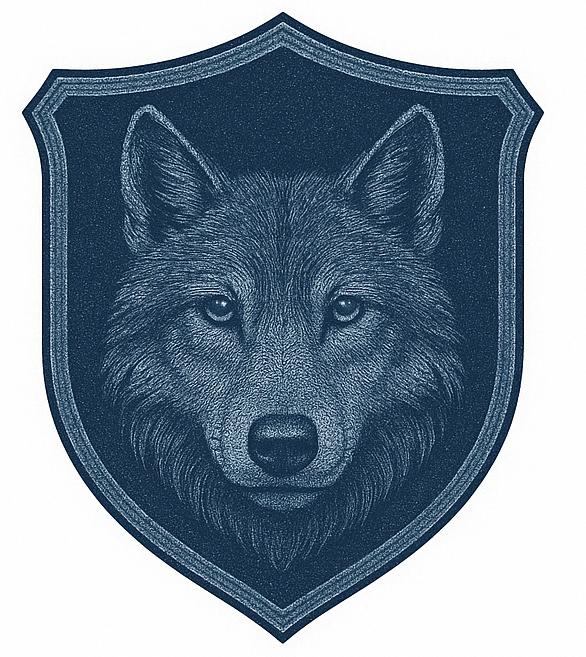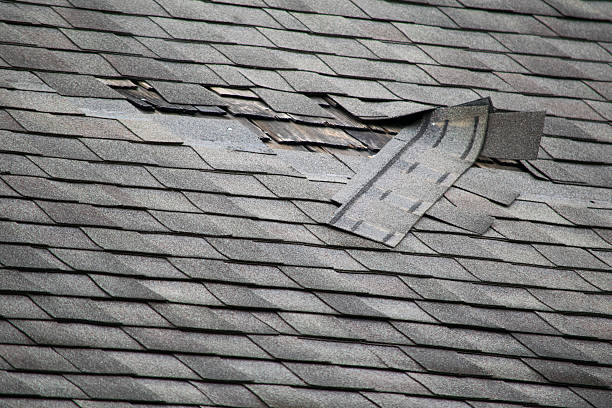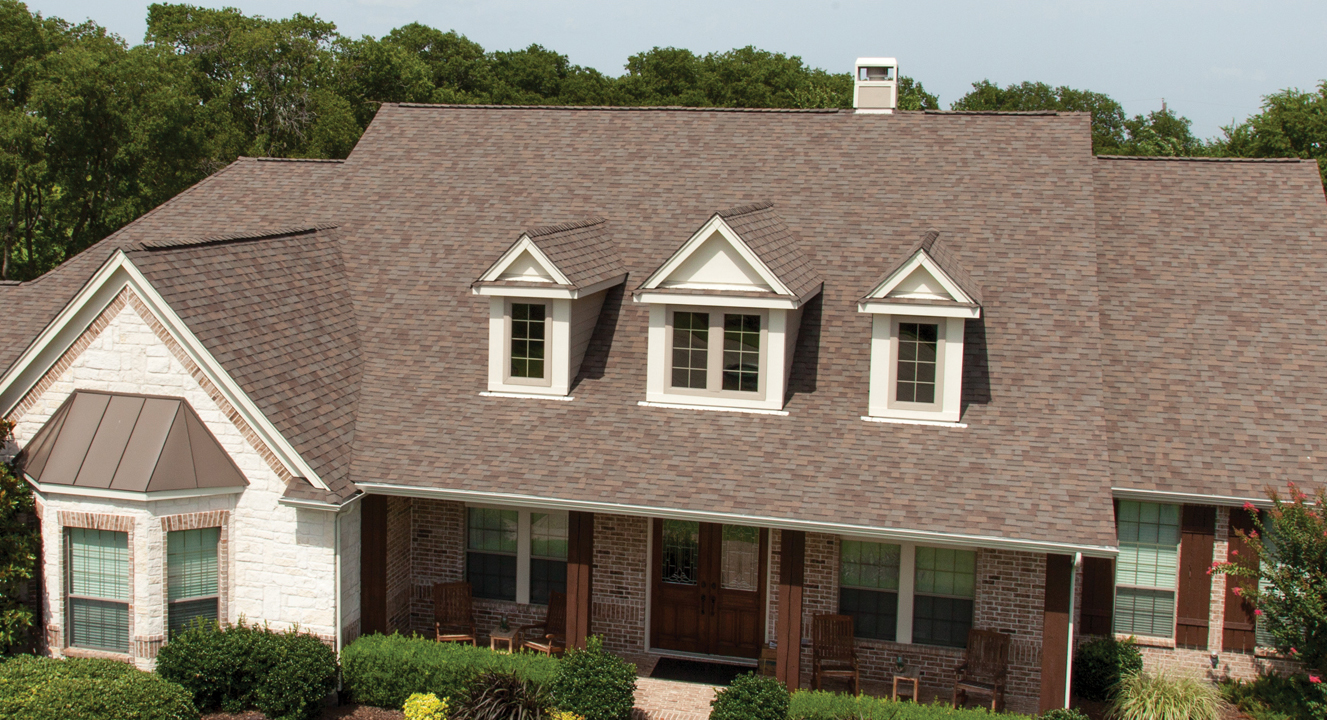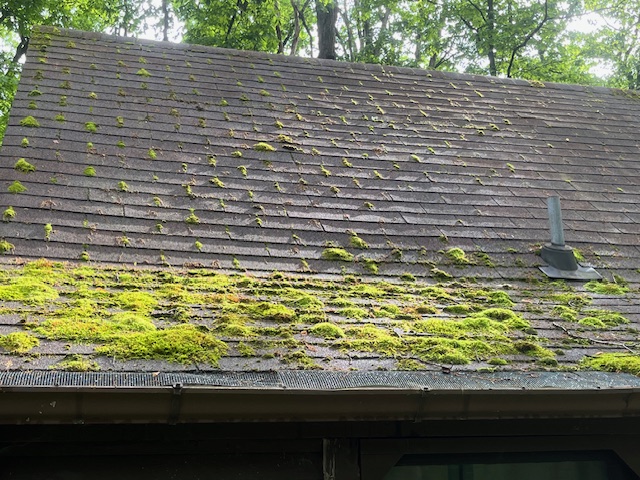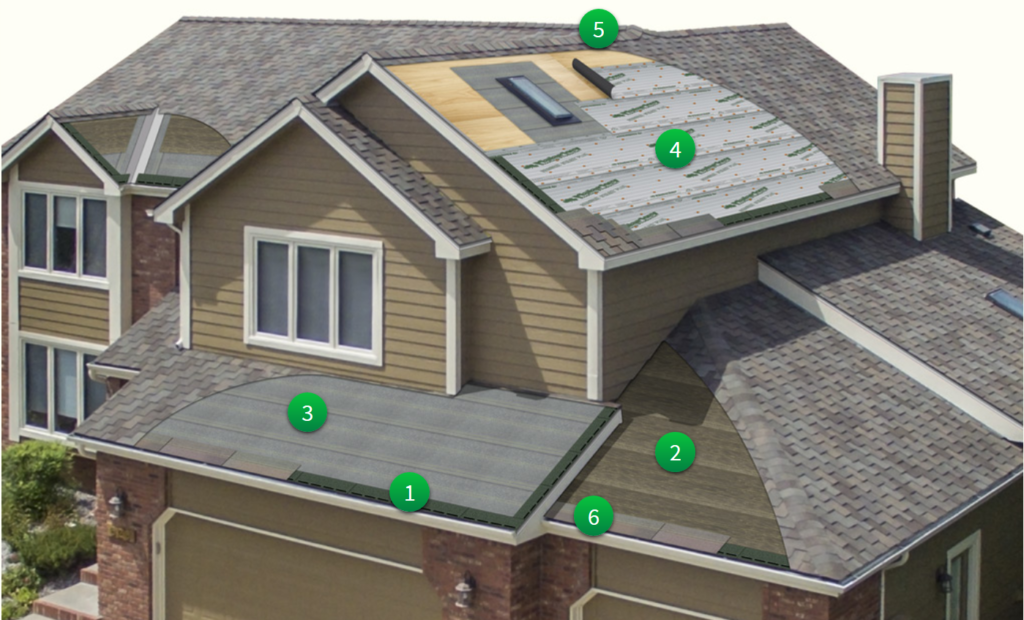Even with preventive maintenance, your roof may still look old and worn, signaling that it’s nearing the end of its lifespan or approaching a potential failure. If a roof needs replacement, it’s advisable not to delay, as postponing can lead to bigger problems and higher costs. Here are the key signs to look out for:
Cupping and Curling of Shingles
- Cupping occurs when shingles develop a concave or depressed center, while curling happens when shingle edges curl under. These deformations can compromise the shingles’ ability to protect your roof from water infiltration, potentially leading to leaks and water damage within your home. Regular inspection for these signs can help you catch issues early before they escalate.
- Cupping occurs when shingles develop a concave or depressed center, while curling happens when shingle edges curl under. These deformations can compromise the shingles’ ability to protect your roof from water infiltration, potentially leading to leaks and water damage within your home. Regular inspection for these signs can help you catch issues early before they escalate.
Bald Spots or Granules Falling Off
- Bald spots form when the protective granules on asphalt shingles fall off, leaving the underlying material exposed to the elements. This granule loss results from weathering over time and can be accelerated by severe weather conditions. Leaks may start at these spots, causing ceiling discoloration and mold in your attic. Additionally, granule loss can indicate ventilation issues that need to be addressed to prevent further damage.
- Bald spots form when the protective granules on asphalt shingles fall off, leaving the underlying material exposed to the elements. This granule loss results from weathering over time and can be accelerated by severe weather conditions. Leaks may start at these spots, causing ceiling discoloration and mold in your attic. Additionally, granule loss can indicate ventilation issues that need to be addressed to prevent further damage.
Thermal Splitting and Cracked Shingles
- Thermal splitting, or cracking, occurs when shingles tear due to the thermal expansion and contraction of the material. Extreme temperatures cause asphalt shingles to expand and contract, leading to tears and splits. This is a clear sign that the shingles installed on your roof may be defective or of low quality. Addressing thermal splitting promptly can prevent water from penetrating your roof and causing significant damage.
- Thermal splitting, or cracking, occurs when shingles tear due to the thermal expansion and contraction of the material. Extreme temperatures cause asphalt shingles to expand and contract, leading to tears and splits. This is a clear sign that the shingles installed on your roof may be defective or of low quality. Addressing thermal splitting promptly can prevent water from penetrating your roof and causing significant damage.
20-Year-Old Roof – Your Roof Looks Old and Worn
- Most asphalt shingles are designed to last between 20 to 30 years, but factors such as poor ventilation, weather conditions, and installation quality can accelerate aging. If your roof is at least 20 years old and you notice signs of wear, it may be time for a replacement. Observing that your neighbors are replacing their roofs can also be a good indicator that your roof’s useful life is nearing its end, especially if your homes were built around the same time.
- Most asphalt shingles are designed to last between 20 to 30 years, but factors such as poor ventilation, weather conditions, and installation quality can accelerate aging. If your roof is at least 20 years old and you notice signs of wear, it may be time for a replacement. Observing that your neighbors are replacing their roofs can also be a good indicator that your roof’s useful life is nearing its end, especially if your homes were built around the same time.
Dark Streaks or Black Spots
- Dark streaks or black spots, commonly caused by airborne algae, may not directly affect the shingles’ functionality but can significantly lower your home’s curb appeal. While these streaks can be removed with a bleach and water solution, their presence often indicates that the protective UV granules are being compromised. Over time, this can lead to shingle damage, such as drying, cracking, curling, or cupping, which can result in leaks.
- Dark streaks or black spots, commonly caused by airborne algae, may not directly affect the shingles’ functionality but can significantly lower your home’s curb appeal. While these streaks can be removed with a bleach and water solution, their presence often indicates that the protective UV granules are being compromised. Over time, this can lead to shingle damage, such as drying, cracking, curling, or cupping, which can result in leaks.
Moss Growth
- Moss typically grows in damp, shaded environments and can establish roots on your roof, holding moisture against the surface. This moisture can damage the granules on the shingles, and if not removed, the roots can lift the shingles, leading to holes in the roof deck and subsequent leaks. Regular removal of moss is essential to maintaining the integrity of your roof and preventing long-term damage.
- Moss typically grows in damp, shaded environments and can establish roots on your roof, holding moisture against the surface. This moisture can damage the granules on the shingles, and if not removed, the roots can lift the shingles, leading to holes in the roof deck and subsequent leaks. Regular removal of moss is essential to maintaining the integrity of your roof and preventing long-term damage.
Sagging Roof Deck
- A sagging roof deck is a serious issue indicating structural problems, often caused by prolonged exposure to moisture or the weight of heavy snow and ice. A sagging deck suggests that the underlying support structure is compromised, and immediate attention is needed to prevent further deterioration and potential collapse. Addressing this issue promptly can save you from more extensive and costly repairs.
- A sagging roof deck is a serious issue indicating structural problems, often caused by prolonged exposure to moisture or the weight of heavy snow and ice. A sagging deck suggests that the underlying support structure is compromised, and immediate attention is needed to prevent further deterioration and potential collapse. Addressing this issue promptly can save you from more extensive and costly repairs.
Shingle Blistering
- Blistering shingles occur when moisture gets trapped within the shingle material, usually due to poor ventilation or a manufacturing defect. When the sun heats the roof, the trapped moisture expands, forming blisters on the shingle surface. Blistering can lead to further deterioration and reduced protection, making your roof more susceptible to leaks and damage. Ensuring proper ventilation can help prevent this issue.
- Blistering shingles occur when moisture gets trapped within the shingle material, usually due to poor ventilation or a manufacturing defect. When the sun heats the roof, the trapped moisture expands, forming blisters on the shingle surface. Blistering can lead to further deterioration and reduced protection, making your roof more susceptible to leaks and damage. Ensuring proper ventilation can help prevent this issue.
Damaged Flashing
- Flashing is installed around chimneys, vents, skylights, and other roof penetrations to prevent water from entering your home. If the flashing is cracked, bent, or missing, it can lead to leaks and water damage. Regular inspection and maintenance of flashing are crucial to ensuring it remains intact and effective. Replacing damaged flashing promptly can prevent water infiltration and protect your home’s interior.
- Flashing is installed around chimneys, vents, skylights, and other roof penetrations to prevent water from entering your home. If the flashing is cracked, bent, or missing, it can lead to leaks and water damage. Regular inspection and maintenance of flashing are crucial to ensuring it remains intact and effective. Replacing damaged flashing promptly can prevent water infiltration and protect your home’s interior.
Excessive Energy Bills
- A sudden increase in your energy bills may indicate that your roof is no longer insulating your home effectively. Poor ventilation, inadequate insulation, or aging shingles can contribute to higher heating and cooling costs. Upgrading to a new roof with modern materials and proper insulation can improve your home’s energy efficiency, lower your utility bills, and enhance overall comfort.
Regular professional roof inspections can help detect these signs early, preventing costly repairs and ensuring your roof continues to protect and enhance your home. A well-maintained roof not only provides essential protection but also adds to the value and curb appeal of your property. Taking proactive steps to address roof issues can save you money and provide peace of mind knowing your home is secure.
Rafael Antonio Huguet Lotterer, Owner of E81 Studio
E81 Premium Roofing – Home of the educated roof Consumer

Give us a call! (240) 205-3758
Or send us an email: info@e81studio.com

